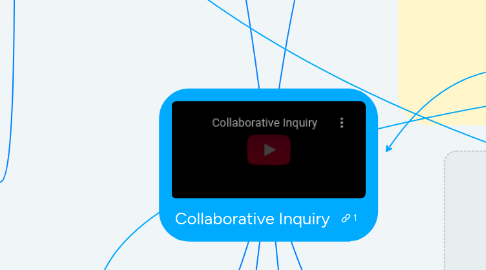
1. Design
1.1. Design models should be cyclical. The process does not end with the reflection
1.1.1. iterative
1.2. Process
1.2.1. identify problems
1.2.2. Generate possible solutions
1.2.3. Evaluate solutions
1.2.4. Reflection
1.2.5. Start over with the newly gathered information
1.3. Design in systems engineering
1.3.1. Understand the problem
1.3.1.1. How can we initiate a design process if the problem is not understood?
1.3.2. Gather information
1.3.3. Analyse information
1.3.4. Synthesize information and wait for creative leap
1.4. What is the strongest collaborative inquiry design model? Does it depend on the context? A Facilitators Guide provides a great starting point
1.5. Behavior and Ecological Approach
1.5.1. 1. Specifically define and clarify concerns
1.5.2. 2. Analyze contexts in which behaviors occur and variables that are hypothesized to affect, control, and reinforce behaviour
1.5.3. 3. Directly assessing the behavior(s) of concern in relevant environments
1.5.4. 4. Intervening directly and in relevant environments
1.5.5. 5. Directly assessing interventions outcomes
1.5.5.1. Needs to be decided by the participants most directly involved. They will not carry out the intervention if they do not feel comfortable with it.
1.6. Much research focuses on outcome rather than process. Much research still needs to be done on proper collaborative techniques.
2. Collaboration
2.1. Grouping together with one or more partners for a common purpose / goal
2.1.1. Requires Trust
2.1.1.1. Clarifying expectations for participation
2.1.1.2. formulate roles and responsibilities for each stakeholder,
2.1.2. Requires respect
2.1.2.1. There is. no "expert". All participants should be seen as having expertise and important contributions
2.1.3. Feeling Included
2.1.3.1. proper collaboration requires that stakeholders are valued participants
2.1.3.2. each participant should have different but equally important contributions and tasks
2.1.4. Problem Solving
2.1.4.1. requires participants to be meaningfully involved
2.1.4.2. all participants should be actively engaged and have vital roles
2.1.4.2.1. How do we ensure that all participants are active and feel like they're contributing?
2.1.4.3. Decision making on data analysis and data sharing should be made together
2.1.5. Relationship
2.1.5.1. The relationship between stakeholders is an important dynamic. Effort should be made to improve the relationships of collaborators prior to and during the collaborative inquiry.
2.1.5.1.1. Step 0 (prior to step 1) should be to build a strong relationship between particpants
2.1.5.2. developing a preferred means of communication
2.1.5.3. dialogue between participants should include smooth transitions
2.1.5.4. Successful collaborators build on each others ideas
2.1.6. Building a Joint Problem Space
2.1.6.1. the JPS allows meaningful conversations about the problem to occur.
2.1.6.2. Must be ways to repair conflicts that reduce the chance of collaborative progress.
2.2. does not just happen because stakeholders are co-present. Collaborators must make a conscious effort with each other to be successful.
3. Burning Questions
3.1. Can I use collaborative inquiry in order to determine ways to introduce my students to more ill-structured problems in the classroom?
3.2. What is the most effective collaborative inquiry design that can be used with other teachers?
3.3. Should there be a different design for each type of problem?
4. Problem Solving
4.1. Ill defined problems (ISD) / Wicked Problems
4.1.1. Experienced on a daily basis
4.1.2. Difficult to prepare people for
4.1.3. Cannot be accomplished with direct instruction strategies
4.1.4. Nearly all public issues are wicked wicked problems
4.1.5. Often the problem cannot be defined until the solution has been found
4.1.5.1. Finding the problem can be the same as finding the solution.
4.1.6. There's no criteria for sufficient understanding of a wicked problem. Making it an iterative process
4.1.7. There may be undesirable repercussions to a decided action.
4.1.8. Wicked require an agreement between collaborators to a point where the action is decided on by a response similar to, "ok, let's try that". Knowing that the action may not have the desired results.
4.1.8.1. Ultimately, the goal is to improve a specific part of the world.
4.2. Well Structured Problems (WSD)
4.2.1. Problems seen in school
4.2.2. can be taught using direct instruction
4.2.3. Many different forms of these problems such as troubleshooting, diagnosis, case analysis and dilemmas. All vary in complexity
4.2.4. These are the problems that scientists usually focus on. Problems that can be hypothesized and solved through trial and error.
4.2.5. No severe consequence for getting it incorrect. A hypothesis is usually created, data is collected and others will build on this information.
4.3. Constructivist Approach
4.3.1. The internet may be the ultimate constructivist learning environment
4.3.1.1. What does the ultimate constructivist learning environment look like?
4.4. Admiring the Problem
4.4.1. The problem solving process often gets stalled when determining what is wrong
4.4.1.1. Efforts should be made to focus on finding solutions rather than more problems.
5. Inquiry
5.1. reflecting on successes and failures
5.2. Asking Questions
5.2.1. Why does this problem situation occur?
5.2.2. What factors contribute to the mismatch that exists between actual and desired level of performance for each target behavior?
5.2.3. What resources are available to help resolve this problem situation?
5.2.4. What is the goal or expected outcome of intervention?
5.2.5. What is the desired level of performance of each target?
5.2.6. What intervention(s) should be tried to improve the problem situation?
5.3. Finding best practice research
5.3.1. Analyzing research using quantitative and qualitative methods
5.4. completing evaluations to determine the best ways to approach a problem
5.5. Science-Practioner Approach
5.5.1. practitioner relies on research to guide assessment and intervention strategies
5.5.2. intervention choices are treated as testable hypotheses
5.5.3. Gather information to answer specific questions
